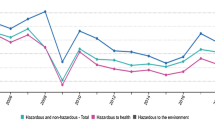Summary
It is well known that the neurotoxicity of n-hexane may be modified upon co-exposure with other organic solvents. In order to elucidate this mechanism further, rats were exposed to 500ppm n-hexane, 500ppm n-hexane plus 500ppm methyl ethyl ketone (MEK), 500ppm n-hexane plus 500ppm toluene, or air only for 8h per day for 33 weeks. The body weight, motor nerve conduction velocity (MCV) and distal latency (DL) were determined before exposure and after 4, 8, 12, 16, 20, 24, 29, and 33 weeks of exposure. From each group one rat was histologically examined after 33 weeks of exposure. To establish a relationship between the n-hexane neurotoxicity and changes in biotransformation, urinary metabolites (2-hexanol, methyl n-butyl ketone (MBK), 2,5-hexanedione, 2,5-dimethylfuran, and γ-valerolactone) were measured by gas chromatography on the first exposure day, and after 1, 2, 4, 8, 12, 16, 20, 24, 29, and 33 weeks of exposure. The total amounts of metabolites of n-hexane in the urine significantly decreased upon co-exposure of n-hexane, with MEK as well as with toluene, in comparison with those of animals exposed to n-hexane alone. 2,5-Hexanedione, which is considered the ultimate neurotoxic metabolite of n-hexane, also decreased. Electrophysiological and histological studies did not reveal statistically significant differences between any two groups among the four groups. It is considered that the present results might explain the combined effects of n-hexane and toluene which decrease n-hexane neurotoxicity, but do not explain those of n-hexane and MEK. Therefore, other mechanisms of the combined effects of n-hexane and MEK should be studied.
Similar content being viewed by others
References
Abdel-Rahman MS, Hetland LB, Couri D (1976) Toxicity and metabolism of methyl butyl ketone. Am Ind Hyg Assoc J 37:95–102
Allen N, Mendell JR, Billmaier DJ, Fontaine RE, O'Neill J (1975) Toxic polyneuropathy due to methyl n-butyl ketone. Arch Neurol 32:209–218
Altenkirch H, Stoltenburg G, Wagner HM (1978) Experimental studies on hexacarbon neuropathies induced by methyl ethyl ketone (MEK). J Neurol 219:159–170
Altenkirch H, Wagner HM, Stoltenburg G, Spencer PS (1982) Nervous system responses of rats to subchronic inhalation of n-hexane and n-hexane + methyl ethyl ketone mixtures. J Neurol Sci 57:209–219
Couri D, Abdel-Rahman MS, Hetland LB (1978) Biotransformation of n-hexane and methyl n-butyl ketone in guinea pigs and mice. Am Ind Hyg Assoc J 39:295–300
DiVincenzo GD, Kaplan CJ, Dedinas J (1976) Characterization of the metabolites of methyl n-butyl ketone, methyl iso-butyl ketone and methyl ethyl ketone in guinea pig serum and their clearance. Clin Toxicol 13:371–376
DiVincenzo GD, Hamilton ML, Kaplan CJ, Dedinas J (1977) Metabolic fate and disposition of 14C-labeled methyl n-butyl ketone in the rat. Toxicol Appl Pharmacol 41:547–560
Graham DG, Abou-Donis MB (1980) Studies of the molecular pathogenesis of hexane neuropathy. I. Evaluation of the inhibition of glyceraldehyde-3-phosphate dehydrogenase by 2,5-hexanedione. J Toxicol Environ Health 6:621–631
Graham DG (1980) Hexane neuropathy: a proposal for pathogenesis of a hazard of occupational exposure and inhalant abuse. Chem Biol Interact 32:339–345
Ishii N, Herskowitz A, Schaumberg H (1972) n-Hexane Polyneuropathy: A clinical and experimental study. J Neuropathol Exp Neurol 31:198
Iwata M, Takeuchi Y, Hisanaga N, Ono Y (1983) A study on biological monitoring of n-hexane exposure. Int Arch Occup Environ Health 51:253–260
Iwata M, Takeuchi Y, Hisanaga N, Ono Y (1983) Changes of n-hexane metabolites in urine of rats exposed to various concentrations of n-hexane and to its mixture with toluene or MEK. Int Arch Occup Environ Health 53:1–8
Mendell JR, Saida K, Ganansia MF, Jackson DB, Weiss H, Gerdier RW, Chrisman C, Allen N, Couri D, O'Neill J, Marks B, Hetland L (1974) Toxic polyneuropathy produced by methyl n-butyl ketone. Science [NY] 185:787–789
Ono Y, Takeuchi Y, Hisanaga N (1979) Studies on the method of measuring nerve conduction velocity in rat's tail and on the comparative toxicity of n-hexane, methyl n-butyl ketone and 2,5-hexanedione [in Japanese with English abstract]. Jpn J Ind Health 21:528–538
Perbellini L, Brugnone F, Pastorello G, Grigolini L (1979) Urinary excretion of n-hexane metabolites in rats and humans. Int Arch Occup Environ Health 42:449–354
Perbellini L, Brugnone F, Faggionato G (1981) Urinary excretion of the metabolites of n-hexane and its isomers during occupational exposure. Br J Ind Med 38:20–26
Perbellini L, Leone R, Fracasso ME, Brugnone F, Venturini MS (1982) Metabolic interaction between n-hexane and toluene in vivo and in vitro. Int Arch Occup Environ Health 50:351–358
Saida K, Mendell J, Weiss HS (1976) Peripheral nerve changes induced by methyl n-butyl ketone and potentiation by methyl ethyl ketone. J Neuropathol Exp Neurol35:207–225
Spencer PS, Sabri MI, Schaumburg HH (1978) Does a defect of energy metabolism in the nerve fiber underlie axonal degeneration in polyneuropathies? Ann Neurol 5:501–507
Spencer PS, Schaumburg HH, Sabri MI, Veronesi B (1980) The enlarging view of hexacarbon neurotoxicity. CRC Crit Rev Toxicol 7:278–356
Takeuchi Y, Ono Y, Hisanaga N, Kitoh J, Sugiura Y (1980) A comparative study on the neurotoxicity of n-pentane, n-hexane, and n-heptane in the rat. Br J Ind Med 37:241–247
Takeuchi Y, Ono Y, Hisanaga N (1981) An experimental study on the combined effects of n-hexane and toluene on the peripheral nerve of the rat. Br J Ind Med 38:14–19
Takeuchi Y, Ono Y, Hisanaga N, Iwata M, Aoyama M, Kitoh J, Sugiura Y (1983) An experimental study of the combined effects of n-hexane and methyl ethyl ketone. Br J Ind Med 40:199–203
Yamada S (1964) An occurrence of polyneuropathy by n-hexane in the polyethylene laminating plants [in Japanese]. Jpn J Ind Health 6:192
Author information
Authors and Affiliations
Rights and permissions
About this article
Cite this article
Iwata, M., Takeuchi, Y., Hisanaga, N. et al. Changes of n-hexane neurotoxicity and its urinary metabolites by long-term co-exposure with MEK or toluene. Int. Arch Occup Environ Heath 54, 273–281 (1984). https://doi.org/10.1007/BF00378580
Received:
Accepted:
Issue Date:
DOI: https://doi.org/10.1007/BF00378580




